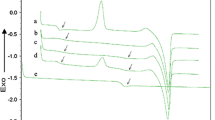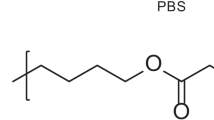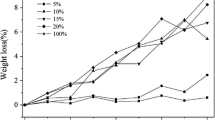Abstract
In order to assess the effects of morphology on the degradation characteristics of high-molecular weight poly(l-lactic acid) (PLA100), specimens of similar sizes were processed by compression moulding and made either amorphous by quenching (PLA100A) or semicrystalline by annealing (PLA100C). PLA100A specimens were allowed to age in iso-osmolar saline and pH 7.4 phosphate buffer at 37° C for periods up to 2 years, whereas PLA100C specimens were studied in the buffer only. Various techniques were used to monitor comparatively the effects of morphology on the mechanism of hydrolytic degradation for these two types of PLA100 specimens: weighing, enzymatic assay, potentiometry, viscoelasticimetry, size-exclusive chromatography, (SEC), X-ray scattering and differential scanning calorimetry. As in the case of non-crystallizable members of the poly(α-hydroxy acid) family, degradation was found to proceed more rapidly in the centre than at the surface for both PLA100A and PLA100C specimens. However, the observed multimodal SEC chromatograms have been assigned primarily to differences of degradation rates in amorphous and crystalline domains, regardless of the initial morphology. Indeed, it was found that initially amorphous PLA100A crystallized as degradation proceeded. Furthermore, PLA100A specimens retained mechanical properties for longer than semicrystalline PLA100C specimens, probably because of the sensitivity of the latter to stress and solvent microcracking. When the integrity of the polymer mass was lost, the residual crystalline matter, initially present or formed during degradation, appeared to be very resistant and was still present in a powdered form after 2 years. It is concluded that the morphology is a critical factor for the degradation of PLA100 and that the degradation of bioresorbable devices derived from this polymer should depend very strongly on both the thermal history and the initial crystallinity. The effects of the morphology do not depend significantly on the nature of the ageing medium, provided that the ionic strength is the same.
Similar content being viewed by others
References
S. M. LI, H. GARREAU and M. VERT,J. Mater. Sci., Mater. Med. Vol. 1, (1990) p. 123.
S. M. LI, PhD thesis, Université de Rouen (1989).
M. VERT,Makromol. Symp. 6 (1986) 109.
C. G. PITT, M. M. GRATZEL, J. L. KIMMEL, J. SURLES and A. SCHINDLER,Biometerials 2(10) (1981) 215.
T. St PIERRE and E. CHIELINI,J. Bioact. Compat. Polym. 2 (1987) 4.
S. J. HOLLAND, B. J. TIGHE and P. L. GOULD,J. Control Res. 4 (1986) 155.
M. VERT, P. CHRISTEL, F. CHABOT and J. LERAY, in “Macromolecular Materials”, edited by G. W. Hastings and P. Ducheyne (CRC Press, Boca Raton, 1984), Ch 4, p. 119.
K. MAKINO, M. ARAKAWA and T. KONDO,Chem. Pharm. Bull. 33 (1985) 1195.
S. M. LI, H. GARREAU and M. VERT,J. Mater. Sci., Mater. Med. Vol. 1, (1990) p. 131.
J. LERAY, M. VERT and D. BLANQUAERT, French Patent Application 76-28163 (1976).
P. DE SANTIS and A. KOVACS,J. Biopolym. 6 (1968) 299.
B. KALB and A. J. PENNINGS,Polymer 21 (1980) 607.
M. VERT and F. CHABOT,Makromol. Chem., Suppl. 5 (1981) 30.
T. NAKAMURA, S. HITOMI, S. WATANABE, Y. SHIMIZU, K. JAMSHIDI, S.-H. HYON and Y. IKADA,J. Biomed. Mater. Res. 23 (1989) 1115.
A. M. REED and D. K. GILDING,Polymer 22 (1979) 494.
P. CHRISTEL, M. VERT, F. CHABOT, H. GARREAU and M. AUDION, in Composites in Biomedical Engineering, Plastic and Rubber Institute Proceedings, (1985) 11/1–11/10.
E. W. FISCHER, H. J. STERZEL and G. WEGNER,Kolloid-Z. Polym. 251 (1973) 980.
Author information
Authors and Affiliations
Rights and permissions
About this article
Cite this article
Li, S., Garreau, H. & Vert, M. Structure-property relationships in the case of the degradation of massive poly(α-hydroxy acids) in aqueous media. J Mater Sci: Mater Med 1, 198–206 (1990). https://doi.org/10.1007/BF00701077
Received:
Accepted:
Issue Date:
DOI: https://doi.org/10.1007/BF00701077




